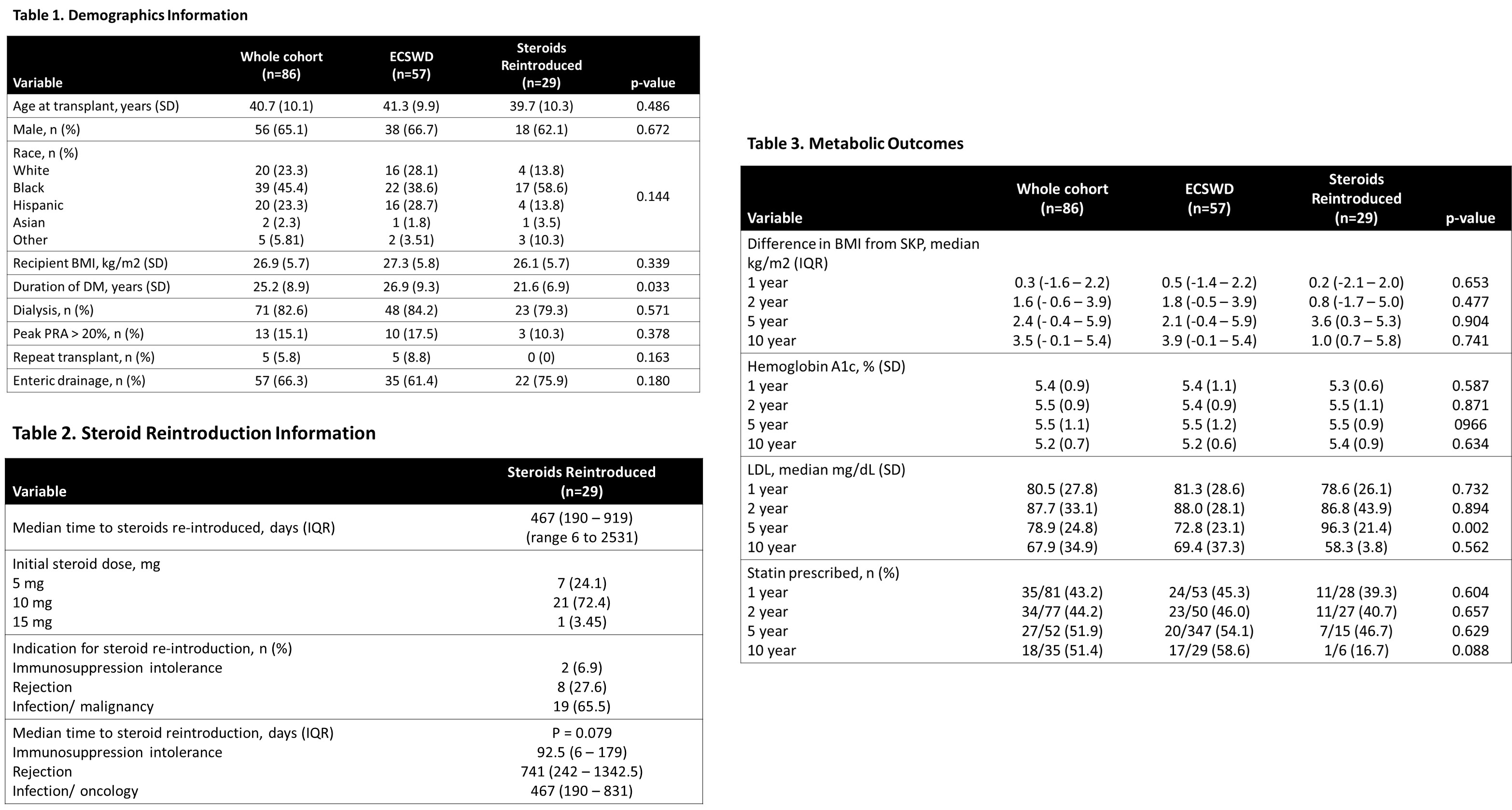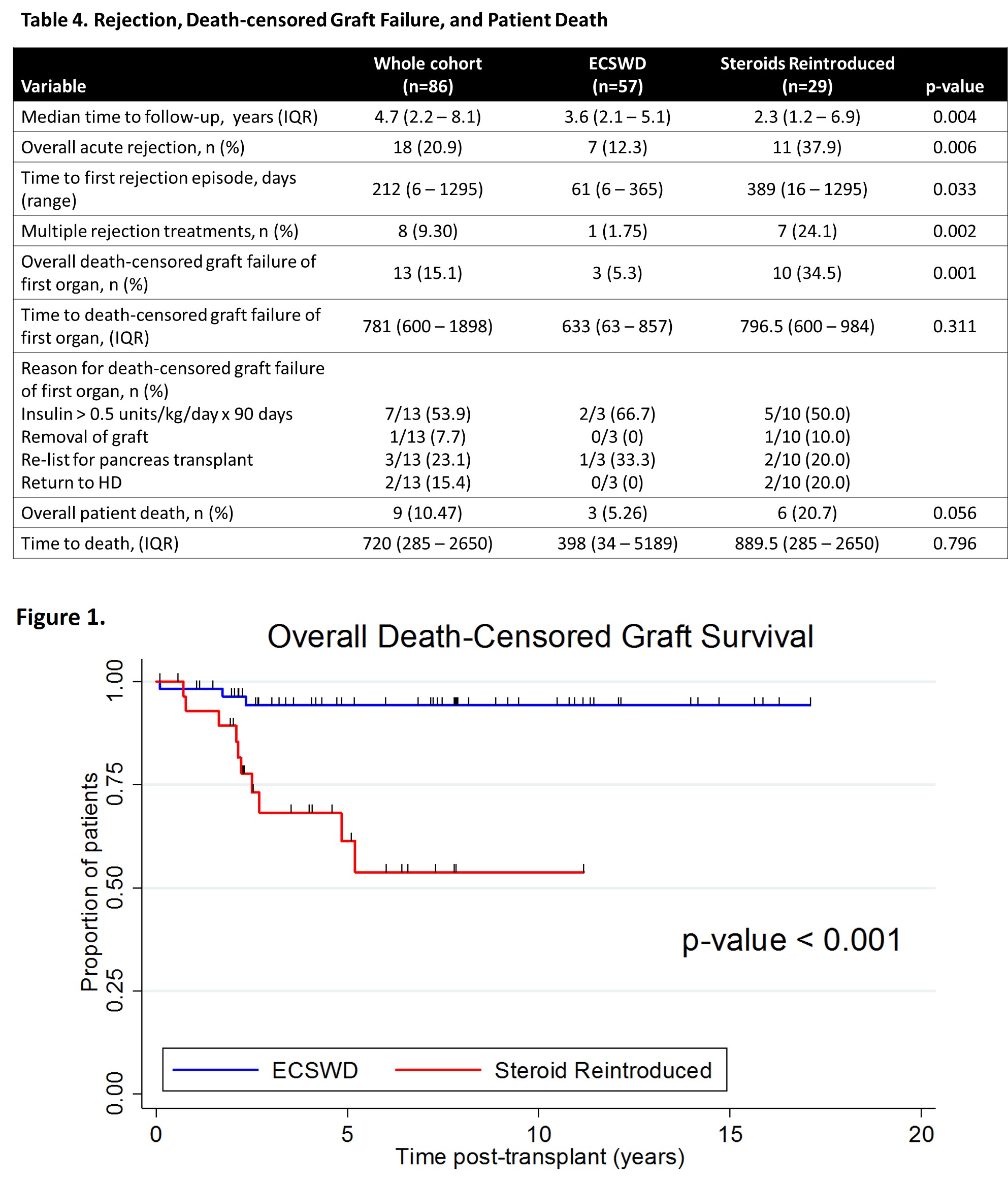Corticosteroid Reintroduction in Urban Simultaneous Kidney-pancreas Transplant Recipients Following an Early Corticosteroid Withdrawal Protocol
D. Pierce, P. West-Thielke, M. Campara, I. Tang, M. Spaggiari, I. Tzvetanov, E. Benedetti, A. Lichvar
University of Illinois at Chicago, Chicago, IL
Meeting: 2021 American Transplant Congress
Abstract number: 1232
Keywords: Graft failure, Metabolic complications, Pancreas transplantation
Topic: Clinical Science » Pancreas » Pancreas and Islet: All Topics
Session Information
Session Name: Pancreas and Islet: All Topics
Session Type: Poster Abstract
Session Date & Time: None. Available on demand.
Location: Virtual
*Purpose: Approximately 30% of patients who undergo simultaneous kidney-pancreas (SKP) transplant are maintained on dual therapy with tacrolimus and mycophenolate. Long-term implications of steroid reintroduction in an early corticosteroid withdrawal (ECSWD) population remain unknown. The purpose of this study is to describe the incidence of corticosteroid reintroduction across an urban ECSWD SKP transplant population.
*Methods: Adult SKP transplant recipients between 1/1/2003 – 12/31/2018 at University of Illinois Hospital & Health Sciences System were assessed. Patients were excluded if they were maintained on steroids post-SKP, had early technical failure, and had graft thrombosis. The primary outcome was to describe the incidence and indication of steroid reintroduction. Acute rejection (defined as biopsy-proven acute rejection [BPAR] or empiric treatment) between the groups. Metabolic parameters were also assessed. Death-censored graft failure (DCGF) and patient survival were compared with survival analyses.
*Results: A total of 86 patients were included. Baseline demographics are detailed in Table 1. Steroids were reintroduced in 33.7% of patients at a median of 467 days (IQR 190 – 919 days) post-SKP. Steroid were restarted for infection/malignancy (65.5%), rejection (27.6%), or immunosuppression intolerance (6.9%) (Table 2). No differences were observed in metabolic parameters (Table 3). The incidence of acute rejection was significantly higher in patients with steroid reintroduction (Table 3). Patients who maintained ECSWD demonstrated less DCGF with no difference in patient survival (Table 4).
*Conclusions: Steroid reintroduction most commonly occurred for infection/malignancy immunosuppression modulation. Patients that necessitated steroid resumption experienced shorter DCGS compared to those patients who were maintained on the ECSWD protocol with no adverse effects on metabolic parameters.
To cite this abstract in AMA style:
Pierce D, West-Thielke P, Campara M, Tang I, Spaggiari M, Tzvetanov I, Benedetti E, Lichvar A. Corticosteroid Reintroduction in Urban Simultaneous Kidney-pancreas Transplant Recipients Following an Early Corticosteroid Withdrawal Protocol [abstract]. Am J Transplant. 2021; 21 (suppl 3). https://atcmeetingabstracts.com/abstract/corticosteroid-reintroduction-in-urban-simultaneous-kidney-pancreas-transplant-recipients-following-an-early-corticosteroid-withdrawal-protocol/. Accessed December 29, 2025.« Back to 2021 American Transplant Congress


